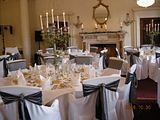

About 1,80 meter high rice plants in a rice field surrounded by jungle. This are by far the tallest rice plants I have ever seen anywhere.
In Cambodia in general all rice plants are stronger and taller than inn the Philippines and all other countries I have seen so far. That is because almost all rice fields are mixed with wild jungle or jungle like wild growth. Such wild growth directly surrounding your plantation is like herbal medicine for any culture properly done. Wild nature and jungle keeps the soil healthy and well balanced as well as all plants strong and free of any illness or insects.
These farmers hve learned from God's jungle and the result is such beautiful rice to harvest.
In album Nature pictures

Pyracantha berries in Ben Lomond, CA USA
Flowers

Winter Berries
Keywords:
< p>beetography
dahlia-s3-DSC_9412.jpg
Another yellow flower
Flowers
pollen-flowers posted a photo

Ballroom - Buxted Park Hotel - 008-9.jpg
pollen-flowers posted a photo

all part of the total Pollen package - 004-7. jpg
I don't generally approve of plants in houses - they never look quite comfortable, not in my home, at least. I've been lucky enough to travel to places where Ficus benjamina are the size of oak trees and Monstera deliciosa are climbing towards a forest canopy. For me it just doesn't feel right to grow them next to the TV.
 But it's a plantaholic's prerogative to change their mind. So I must confess I was secretly delighted to discover at Tatton what could become my ideal houseplant.
But it's a plantaholic's prerogative to change their mind. So I must confess I was secretly delighted to discover at Tatton what could become my ideal houseplant.
The Hawaiian palm (brighamia) is not so much a jungle escapee desperately pining for the rainforest - it's more of an endangered species in need of fostering. Raised from seed by Dutch nursery Plant Planet, these beautiful plants can be grown happily in your living room. And as there are only seven specimens left in the wild, the IUCN is desperate to bring attention to them.
That's a pretty good reason to grow one. They need little watering and have the added bonus of flowering in deepest, darkest winter. I think I have the perfect spot in mind.
Camilla Phelps, Gardening Editor
Info from:
Private Club



No comments:
Post a Comment